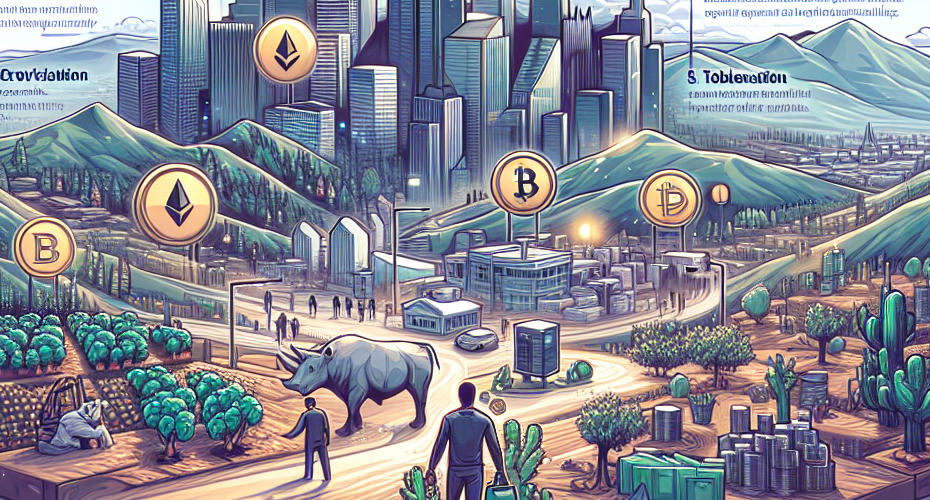In recent years, the term "coinization" has been at the center of the digital economy. Coinization doesn't just mean digital assets, it's an innovative way of creating value based on blockchain technology.
In this article, we'll cover the basic concepts of coinage, its relationship to blockchain, its historical background, its advantages and disadvantages, and how it's being applied to our lives through real-world examples. We'll also look ahead to where coinage is likely to go in the future. Whether you're new to coinage or want to understand it more deeply, we hope you'll find this a useful guide.
Basic Concepts of Coinization
Coinization is a form of digital asset that is based on blockchain technology. In this section, we'll review the basic concepts and important elements of coinization.
Definition and characteristics of coins
- Define **coin**: A coin is a digital currency that uses blockchain technology to record and verify transactions.
- Attribute
- Decentralized: Transactions are validated by network participants without a central authority.
- Transparency: All transaction records are publicly available on the blockchain and can be viewed by anyone.
- Security: Transactions are protected through encryption technology.
Types of coins
- Bitcoin (BTC)
- The first cryptocurrency created
- So limited in supply that it's been called digital gold
- **Ethereum (ETH)** **Ethereum (ETH)
- Adding smart contract functionality
- Use it to develop a variety of applications
- Ripple (XRP)
- Fast international money transfers
- Facilitate transactions between financial institutions
Benefits of coins
- Transaction speed: Faster transaction processing than traditional financial systems.
- Low fees: Fees are low because there's no middleman.
- Global accessibility: You can trade from anywhere in the world with an internet connection.
Coinization is a new financial innovation for the digital age, and with the advancement of blockchain technology, it offers many possibilities.
The relationship between blockchain and coinization
Blockchain and coinization go hand in hand, and understanding them will give you a deeper understanding of why blockchain is such a revolutionary technology. In this section, we'll cover the basic concepts of blockchain and the key elements of coinization.
Basic concepts of blockchain
Blockchain is a decentralized database system that records and shares information. Its main characteristics include
- Distributed ledger: All participants have the same data, ensuring transparency and trust.
- Unalterable: Once recorded, data cannot be altered, preserving the integrity of the data.
- Transaction history: All transactions are systematically recorded and traceable.
What is coinization?
Coinization refers to the process of creating and trading digital assets through blockchain technology. It is primarily associated with cryptocurrencies and includes the following elements
- Token issuance: Digital tokens are issued that can be used on a specific platform.
- Exchange Listed: These tokens can be traded on a variety of exchanges.
- Smart contract: An automated contract that is executed automatically when predefined conditions are met.
| element | Description. |
|---|---|
| Cryptocurrency | A digital currency that is traded on a blockchain network. |
| Token | A digital asset issued for a specific use or service. |
| Smart contracts | An automated contract that executes automatically when conditions are met. |
Real-world examples of blockchain and coinization
Blockchain and coinization are revolutionizing a wide range of industries, to name a few:
- Finance: acts as a replacement or complement to existing financial systems, improving transaction speed and transparency.
- Real estate: Increase the transparency of property transactions and reduce intermediary costs.
- Healthcare: Manage and share patient data securely to improve the quality of healthcare.
The history and evolution of coinage
Coinization has become increasingly popular through the development and evolution of digital currencies. In this section, we'll explain how it got started and how it reached its current form.
The emergence and history of early coins
Bitcoin is a digital currency that first appeared in 2009 and was developed by an anonymous person named Satoshi Nakamoto.
Bitcoin is a decentralized system based on blockchain technology, which makes transactions more transparent and secure.
Since then, Litecoin, Ethereum, and other altcoins have been introduced to the market, expanding the variety and availability of digital currencies.
The evolution of digital currencies
| Year | Top Events |
|---|---|
| 2009 | Mining Bitcoin's first block, the Genesis block |
| 2011 | Litecoin Launch |
| In 2015 | Ethereum Mainnet Launch |
| In 2017 | The Initial Coin Offering (ICO) craze |
Applications and future prospects of modern coins
Currently, coins are utilized in various fields such as payments, remittances, and smart contracts.
Blockchain technology has been applied in the financial industry, but also in art, games, file storage systems, and more, making coins even more important.
In the future, the utility and value of the coin is expected to increase further as it integrates with more industries.
The process of coinization is more than just a change in digital currencies, it has spawned a host of innovations centered around blockchain technology that are having a profound impact on our economy and society as a whole, and we look forward to seeing how it continues to evolve.
Key advantages of coinization
Increase transparency and security
Because coinized data is recorded on the blockchain, it can be accessed and verified by anyone. This ensures transparency of transactions and reduces the likelihood of fraud and tampering.
- Transparency: all transactions are public and verifiable by anyone
- Increased security: Prevent hacking by using distributed systems rather than centralized systems
Reduce costs
The traditional financial system is expensive due to the number of intermediaries and procedures. However, with coinization, transactions are made directly without these intermediaries, significantly reducing costs.
- Reduced intermediary costs**: Reduce costs by cutting out the middleman
- Increased speed: Save additional costs with faster transaction processing times
Increase liquidity
Coinized assets become more liquid because they can be easily traded in digital form. This is a big change, especially for illiquid assets like real estate or art.
- Instantly tradeable: trade digital assets anytime, anywhere
- More market access: Easily trade in global markets
These key advantages of coinization are revolutionizing a wide range of industries, and we expect to see many more applications in the future.
Risks and disadvantages of coinization
Coinization technology is gaining a lot of attention as a new financial trend based on the innovative blockchain system, but with any rapidly emerging technology like this, there are bound to be risks and downsides.
Risk of market volatility
Coinized assets are typically highly volatile. This is a potential risk factor that can lead to large losses for investors.
- Rapid price fluctuations**: The value of a coin can change significantly in a short period of time, which creates an unpredictable situation for market participants.
- Speculative nature: Many investors may act speculatively for short-term gains, which can undermine market stability.
Security and hacking issues
One of the advantages of blockchain technology is its high security, but there is still a risk of hacking.
- Exchange hacks: Exchanges that trade a lot of coins can be prime targets for hackers, and several exchanges have been hacked in the past.
- Security of personal wallets: Wallets owned by individuals can also be hacked, which can lead to loss of personal property.
Legal and regulatory issues
Different countries have different legal regulations regarding coinization, which can add uncertainty for investors.
- Regulatory uncertainty: Some countries do not yet have clear regulations in place, so investors may be unexpectedly affected by future legislation.
- Money laundering and criminal use: Due to the anonymous nature of blockchain, there is the potential for it to be used for money laundering or other criminal activity.
The risks and disadvantages of coinization can manifest themselves in many ways, as shown above, and it's important to consider these factors carefully.
Real-world applications of coinization
Coinization is one of the many applications of blockchain that are revolutionizing many sectors. In this section, we'll explore specific use cases for coinization.
Digital asset management
Coinization is playing an important role in the digital asset management space.
- Cryptocurrency exchanges: On cryptocurrency exchanges, various digital assets are tokenized and traded. This helps to increase liquidity and enhance safety.
- Digital artwork: Non-fungible tokens (NFTs) allow digital artwork to be recognized and traded as unique assets.
- Game items: In-game items can also be freely traded between users through coinization, which is becoming a new revenue model for the gaming industry.
Real estate
Coinization is also making a big difference in real estate.
- Real estate tokenization: Tokenizing real estate assets will allow small investors to participate. This makes the asset more liquid and accessible.
- Smart contracts: Use smart contracts in real estate transactions to automate contracts and create transparency. This contributes to reducing transaction costs and increasing trust.
Financial services
Coinization is also being used in financial services in a variety of ways.
- Lending and borrowing**: Decentralized finance (DeFi) has led to the emergence of services that allow you to take out loans using cryptocurrency as collateral.
- Payment systems: The proliferation of payment systems using cryptocurrencies is increasingly blurring the lines between traditional financial systems.
- Crowdfunding**: Blockchain-based crowdfunding platforms allow investments in projects to be made transparently and securely.
As you can see, coinization is becoming a disruptive technology in a variety of industries and is expected to be used in many more in the future.
The future of coinization
The future of coinization is a hot topic with blockchain technology evolving every day. In this area, we'll take a look at the changes and innovations ahead, as well as the challenges we can expect.
Key trends and expected developments
In recent years, cryptocurrency has found widespread application in a variety of industries. As a result, many experts are predicting the following key trends and developments:
* **Growth of Decentralized Finance (DeFi): Decentralized finance, the provision of financial services without a central authority, is a prominent application of coinization. It provides accessibility to a wider audience and can overcome the limitations of the traditional financial system.
* Expand the use of smart contracts: Smart contracts are agreements that automatically execute when certain conditions are met. They increase the reliability and efficiency of transactions and are expected to be utilized in a variety of industries.
* **The evolution of non-fungible tokens (NFTs): In fields such as art, music, and gaming, NFTs are becoming an important tool for proving ownership of creative works. This is creating new business models.
Technical challenges
The evolution of coinization comes with a number of technical challenges. Meeting these challenges will be key to future success:
* **Scalability issues**: Many blockchain networks currently struggle to process many transactions simultaneously. To address this, various scalability solutions are being researched.
* **Security enhancements**: Blockchain and coinization systems are susceptible to hacking and security vulnerabilities, so they require constant security updates and hardening.
* **Regulation and standardization**: Different countries have different regulatory policies, which can hinder the consistency of the global coinization ecosystem. International cooperation and standardization efforts are needed.
Social and economic impact
The spread of coinization will have a wide range of impacts across society and the economy, and we need to be ready for them:
* **Creation of new jobs**: Many new jobs are expected to be created in related fields such as blockchain developers, data analysts, security specialists, etc.
* Increased financial inclusion: Coinization will allow populations that have not had access to financial services to participate in the financial system, which will significantly improve financial inclusion.
* **Changes in traditional industries**: There will be major disruption in traditional industries, especially in finance, real estate, logistics, etc. Companies will need to adapt quickly.
The future of coinization is very bright and holds endless possibilities, but it also presents a number of challenges. It's important to make sure your strategy takes these into account.



